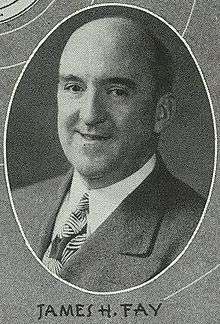James H. Fay
James Herbert Fay (April 29, 1899 – September 10, 1948) was an American lawyer and Democratic politician. He served as a member of the United States House of Representatives from New York.

James H. Fay, Congressman from New York
Born in New York City, Fay was awarded a Purple Heart during his service in the military in World War I, where he lost one of his legs. He graduated from Brooklyn Law School in 1929.
In 1938, he was elected to Congress and served from January 3, 1939 to January 3, 1941. In 1940, Fay lost his bid for reelection to the Republican candidate, William T. Pheiffer. Fay defeated Pheiffer in 1942 by 80 votes and returned to his seat in Congress, serving from January 3, 1943 to January 3, 1945.
Sources
- United States Congress. "James H. Fay (id: F000051)". Biographical Directory of the United States Congress.
- James H. Fay at Find a Grave
| U.S. House of Representatives | ||
|---|---|---|
| Preceded by John J. O'Connor |
Member of the U.S. House of Representatives from New York's 16th congressional district 1939–1941 |
Succeeded by William T. Pheiffer |
| Preceded by William T. Pheiffer |
Member of the U.S. House of Representatives from New York's 16th congressional district 1943–1945 |
Succeeded by Ellsworth B. Buck |
gollark: However, this does not actually stop multiple people having the same nick, which is no.
gollark: Basically, osmarksunnecessaryIRCserver™ receives connections from clients, for purposes. They are not actually considered registered until they set a nickname. So I currently have it loop and receive messages until it gets `NICK bees` or whatever, at which point it sends the welcome messages, write-locks the global state struct™, writes in the new client connection, and adds the nick to the in-use map.
gollark: Yes, but that would be annoying.
gollark: Hmm. It looks like I need software transactional memory or something, but ææææææ there are not really any good libraries for that?
gollark: What of Haskell 2010's 1274128946128946187461876481648 extensions?
This article is issued from Wikipedia. The text is licensed under Creative Commons - Attribution - Sharealike. Additional terms may apply for the media files.